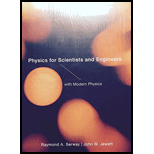
Concept explainers
(a)
The rate of change of radius
(a)
Answer to Problem 28P
The rate of change of radius
Explanation of Solution
Write the expression to obtain the kinetic energy of the particle.
Here,
Write the expression to obtain the rate of change of energy.
Here,
Substitute
Write the expression to obtain the speed of the particle.
Here,
Substitute
Further solve the above equation.
Therefore, the rate of change of radius
(b)
The comparison of path of the proton in figure 29.16a with the result in part (a).
(b)
Answer to Problem 28P
The path of the proton in figure 29.16a is unrealistic according to the result in part (a).
Explanation of Solution
Consider equation (II).
From the above expression the rate of change of radius with time is inversely proportional to the radius
In case of the figure 29.16a, the spiral path of the proton is equally spaced throughout.
Therefore, the path of the proton in figure 29.16a is unrealistic according to the result in part (a).
(c)
The rate of change of radial position before the proton leaves the cyclone.
(c)
Answer to Problem 28P
The rate of change of radial position before the proton leaves the cyclone is
Explanation of Solution
Conclusion:
Substitute
Therefore, the rate of change of radial position before the proton leaves the cyclone is
(d)
The increase in radius of the path of the proton during its last full revolution.
(d)
Answer to Problem 28P
The increase in radius of the path of the proton during its last full revolution is
Explanation of Solution
Write the expression to obtain the increase in radius of the path of the proton during its last full revolution.
Here,
Write the expression to obtain the time required to complete one full orbit revolution by the proton.
Here,
Conclusion:
Substitute,
Substitute
Therefore, the increase in radius of the path of the proton during its last full revolution is
Want to see more full solutions like this?
Chapter 29 Solutions
Physics For Scientists And Engineers With Modern Physics, 9th Edition, The Ohio State University
- 3. If the force of gravity stopped acting on the planets in our solar system, what would happen? a) They would spiral slowly towards the sun. b) They would continue in straight lines tangent to their orbits. c) They would continue to orbit the sun. d) They would fly straight away from the sun. e) They would spiral slowly away from the sun. 4. 1 The free-body diagram of a wagon being pulled along a horizontal surface is best represented by A F N B C 0 Ꭰ FN E a) A b) B c) C app app The app 10 app d) e) ס ח D E 10 apparrow_forwardPls help ASAParrow_forwardPls help asaparrow_forward
- Pls help asaparrow_forwardThe acceleration of an object sliding along a frictionless ramp is inclined at an angle 0 is 9. a) g tano b) g cose c) g sino 10. d) g e) zero A 1.5 kg cart is pulled with a force of 7.3 N at an angle of 40° above the horizontal. If a kinetic friction force of 3.2 N acts against the motion, the cart's acceleration along the horizontal surface will be a) 5.0 m/s² b) 1.6 m/s² c) 2.4 m/s² 11. d) 1.0 m/s² e) 2.7 m/s² What is the net force acting on an object with a mass of 10 kg moving at a constant velocity of 10 m/s [North]? a) 100 N [North] b) 100 N [South] 10 N [North} d) 10 N [South] e) None of these.arrow_forwardModified True/False - indicate whether the sentence or statement is true or false. If the statement is false, correct the statement to make it true. 12. An object in uniform circular motion has a constant velocity while experiencing centripetal acceleration. 13. An object travelling in uniform circular motion experiences an outward centrifugal force that tends to pull the object out of the circular path. 14. An object with less inertia can resist changes in motion more than an object with more inertia. 15. For an object sliding on a horizontal surface with a horizontal applied force, the frictional force will always increase as the applied force increases.arrow_forward

 Glencoe Physics: Principles and Problems, Student...PhysicsISBN:9780078807213Author:Paul W. ZitzewitzPublisher:Glencoe/McGraw-Hill
Glencoe Physics: Principles and Problems, Student...PhysicsISBN:9780078807213Author:Paul W. ZitzewitzPublisher:Glencoe/McGraw-Hill Physics for Scientists and Engineers, Technology ...PhysicsISBN:9781305116399Author:Raymond A. Serway, John W. JewettPublisher:Cengage Learning
Physics for Scientists and Engineers, Technology ...PhysicsISBN:9781305116399Author:Raymond A. Serway, John W. JewettPublisher:Cengage Learning College PhysicsPhysicsISBN:9781305952300Author:Raymond A. Serway, Chris VuillePublisher:Cengage Learning
College PhysicsPhysicsISBN:9781305952300Author:Raymond A. Serway, Chris VuillePublisher:Cengage Learning Principles of Physics: A Calculus-Based TextPhysicsISBN:9781133104261Author:Raymond A. Serway, John W. JewettPublisher:Cengage Learning
Principles of Physics: A Calculus-Based TextPhysicsISBN:9781133104261Author:Raymond A. Serway, John W. JewettPublisher:Cengage Learning College PhysicsPhysicsISBN:9781285737027Author:Raymond A. Serway, Chris VuillePublisher:Cengage Learning
College PhysicsPhysicsISBN:9781285737027Author:Raymond A. Serway, Chris VuillePublisher:Cengage Learning





